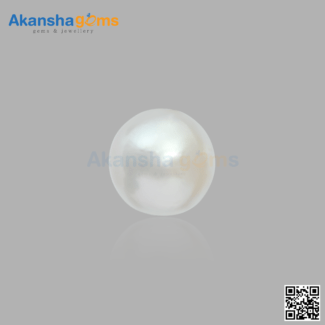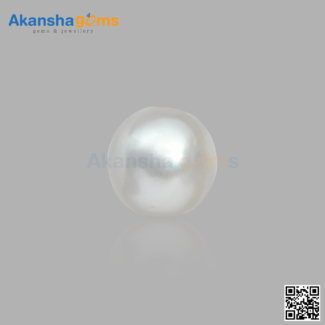| Feature | Description |
|---|---|
| Product Name | Pearl (Moti), 7.20 Carats |
| Color | White |
| Shape | Round |
| Gram | 1.44 Gram |
| Ratti | 8.00 Ratti |
| Surface | Smooth, Slightly blemished |
| Origin | South Sea |
| Cultivation | Natural, Cultured |
| Treatment | Natural, Unheated, and Untreated |
| Certification | GIA, IGI, IGI-GTL, and GJEPC |
| Benefits | Bears’ anger, skin, and Heart increase maternal Relationships and also for better Eyes. |
| Common Uses | Jewelry, accessories, and embellishments |
| Care Instructions | Avoid contact with perfumes, chemicals, and cosmetics. Clean with mild soap and water, and store separately in a soft pouch or cloth when not in use. |
Unveiling the Elegance and Timeless Beauty of Pearl Stone
In the realm of gemstones, few possess the ethereal charm and timeless allure of the pearl stone. Revered for centuries for its luminous beauty and symbolic significance, the pearl stone holds a special place in the hearts of gem enthusiasts and jewelry connoisseurs alike. Let’s embark on a journey to discover the enchanting world of pearl stone and unravel its mysteries.
Origin and Formation
Unlike most gemstones that are mined from the earth, pearls are formed within the soft tissue of mollusks, primarily oysters and mussels. When an irritant, such as a grain of sand or a parasite, enters the mollusk’s shell, it secretes layers of nacre, a crystalline substance composed mainly of calcium carbonate, to coat the intruder. Over time, these layers accumulate, forming a lustrous pearl.
Pearls can be classified into two main categories: natural pearls, which form without human intervention, and cultured pearls, which are cultivated through a process where a nucleus is implanted into the mollusk to stimulate pearl production. Cultured pearls are more commonly found in today’s jewelry market, while natural pearls are considered rare and highly valuable.
Varieties and Colors
Pearls come in a wide range of colors, shapes, and sizes, each possessing its own unique beauty and charm. While the classic white pearl is perhaps the most iconic, pearls can also be found in shades of cream, pink, peach, lavender, black, and even gold. The color of a pearl is influenced by factors such as the type of mollusk, water quality, and environmental conditions.
In addition to their natural hues, pearls can undergo treatments to enhance their color or luster. However, natural pearls, with their iridescent luster and subtle nuances, remain highly prized by collectors and enthusiasts for their organic beauty and rarity.
Symbolism and Cultural Significance
Throughout history, pearls have been revered as symbols of purity, wisdom, and feminine grace. In many cultures, they are associated with love, fertility, and prosperity, making them popular choices for bridal jewelry and heirloom pieces passed down through generations.
In ancient Rome, pearls were considered the ultimate status symbol, worn by aristocrats and royalty to flaunt their wealth and power. In the Islamic tradition, pearls are mentioned in the Quran as symbols of beauty and purity, while in Eastern cultures such as China and Japan, they are believed to bring good fortune and ward off evil spirits.
Metaphysical Properties and Healing Benefits
Pearls are prized not only for their beauty but also for their purported metaphysical properties and healing powers. In holistic medicine, pearls are associated with calming and soothing effects, promoting emotional balance and stress relief. They are also said to enhance intuition, creativity, and spiritual enlightenment.
In astrology, pearls are associated with the planet Moon and are believed to influence emotions, intuition, and feminine energy. They are often recommended for individuals seeking emotional healing, inner peace, and spiritual growth.
Conclusion
In a world where beauty is often fleeting, the pearl stone stands as a timeless symbol of elegance, purity, and enduring grace. From their humble origins within the depths of the ocean to adorning the necks of queens and empresses, pearls have captured the imagination and hearts of humanity for centuries. As we marvel at their iridescent beauty and contemplate their profound symbolism, we are reminded of the eternal allure of nature’s treasures and the enduring legacy of the pearl stone.
Frequently Asked Questions (FAQs) about Pearl Stone
- A pearl stone is a naturally occurring gemstone formed within the soft tissue of mollusks, primarily oysters and mussels. It is composed of layers of nacre, a crystalline substance that gives pearls their characteristic luster and iridescence.
- Pearl stones are formed when an irritant, such as a grain of sand or a parasite, enters the mollusk’s shell and triggers the secretion of nacre to coat the intruder. Over time, these layers of nacre accumulate, forming a pearl.
- Pearl stones come in a wide range of colors, including white, cream, pink, peach, lavender, black, and gold. The color of a pearl is influenced by factors such as the type of mollusk, water quality, and environmental conditions.
- Natural pearls form without human intervention when an irritant enters the mollusk’s shell, while cultured pearls are cultivated through a process where a nucleus is implanted into the mollusk to stimulate pearl production. Cultured pearls are more commonly found in today’s jewelry market, while natural pearls are rare and highly valuable.
- Pearls have been revered in various cultures as symbols of purity, wisdom, and feminine grace. They are associated with love, fertility, and prosperity, making them popular choices for bridal jewelry and heirloom pieces. In some cultures, pearls are believed to bring good fortune and ward off evil spirits.

















Reviews
There are no reviews yet.